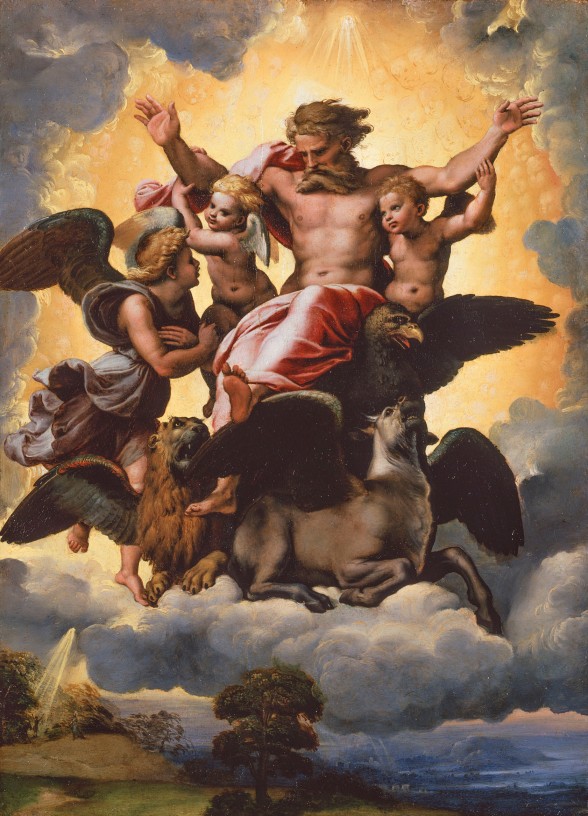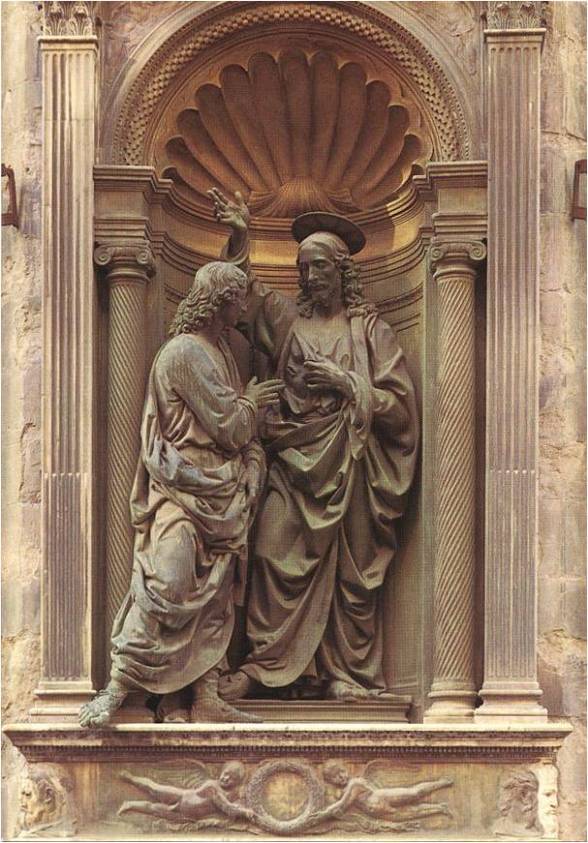As the LORD spoke to me, the spirit entered into me
and set me on my feet,
and I heard the one who was speaking say to me:
Son of man, I am sending you to the Israelites,
rebels who have rebelled against me;
they and their ancestors have revolted against me to this very day.
Hard of face and obstinate of heart
are they to whom I am sending you.
But you shall say to them: Thus says the Lord GOD!
And whether they heed or resist—for they are a rebellious house—
they shall know that a prophet has been among them.
Ezekiel 2:2-5
The prophet Ezekiel was writing during the Jews’ exile to Babylon by King Nebuchadnezzar in 597 BC. As we hear in today’s lectionary reading, the Lord speaks to Ezekiel and charges him with the thankless task of calling the Jews from their sinful ways. In the chapter preceding this one, however, we read Ezekiel’s description of his initial vision of God on the Cherubim, and a phantasmagoric vision it is indeed:
In the thirtieth year, on the fifth day of the fourth month, while I was among the exiles by the river Chebar, the heavens opened, and I saw divine visions.— On the fifth day of the month—this was the fifth year of King Jehoiachin’s exile— the word of the Lord came to the priest Ezekiel, the son of Buzi, in the land of the Chaldeans by the river Chebar. There the hand of the Lord came upon him.
As I watched, a great stormwind came from the North, a large cloud with flashing fire, a bright glow all around it, and something like polished metal gleamed at the center of the fire. From within it figures in the likeness of four living creatures appeared. This is what they looked like: They were in human form, but each had four faces and four wings, and their legs were straight, the soles of their feet like the hooves of a bull, gleaming like polished brass. Human hands were under their wings, and the wings of one touched those of another. Their faces and their wings looked out on all their four sides; they did not turn when they moved, but each went straight ahead.
Their faces were like this: each of the four had a human face, and on the right the face of a lion, and on the left, the face of an ox, and each had the face of an eagle. Such were their faces. Their wings were spread out above. On each one, two wings touched one another, and the other two wings covered the body. Each went straight ahead. Wherever the spirit would go, they went; they did not change direction when they moved. And the appearance of the living creatures seemed like burning coals of fire. Something indeed like torches moved back and forth among the living creatures. The fire gleamed intensely, and from it lightning flashed. The creatures darting back and forth flashed like lightning.
As I looked at the living creatures, I saw wheels on the ground, one alongside each of the four living creatures. The wheels and their construction sparkled like yellow topaz, and all four of them looked the same: their construction seemed as though one wheel was inside the other. When they moved, they went in any of the four directions without veering as they moved. The four of them had rims, high and fearsome—eyes filled the four rims all around. When the living creatures moved, the wheels moved with them; and when the living creatures were raised from the ground, the wheels also were raised. Wherever the spirit would go, they went. And they were raised up together with the living creatures, for the spirit of the living creatures was in the wheels. Wherever the living creatures moved, the wheels moved; when they stood still, the wheels stood still. When they were lifted up from the earth, the wheels were lifted up with them. For the spirit of the living creatures was in the wheels.
Above the heads of the living creatures was a likeness of the firmament; it was awesome, stretching upwards like shining crystal over their heads. Beneath the firmament their wings stretched out toward one another; each had two wings covering the body. Then I heard the sound of their wings, like the roaring of mighty waters, like the voice of the Almighty. When they moved, the sound of the tumult was like the din of an army. And when they stood still, they lowered their wings. While they stood with their wings lowered, a voice came from above the firmament over their heads.
Above the firmament over their heads was the likeness of a throne that looked like sapphire; and upon this likeness of a throne was seated, up above, a figure that looked like a human being. And I saw something like polished metal, like the appearance of fire enclosed on all sides, from what looked like the waist up; and from what looked like the waist down, I saw something like the appearance of fire and brilliant light surrounding him. Just like the appearance of the rainbow in the clouds on a rainy day so was the appearance of brilliance that surrounded him. Such was the appearance of the likeness of the glory of the Lord. And when I saw it, I fell on my face and heard a voice speak.
Ezekiel 1:1-28
This mystifying vision has perplexed and exercised the imaginations of readers, writers, and artists ever since. The so-called chariot described in the passage, the merkavah or merkabah, has even spawned a tradition of mystical Judaism and comparisons with the Temple of Solomon.
Church father Jerome wrote in the preface to his commentary on Matthew’s gospel that Ezekiel’s vision of the Cherubim actually predicted the Gospels, since each one represents a Gospel author:
“The first face of a man signifies Matthew, who began his narrative as about a man…the second [face signifies] Mark in whom the voice of a lion roaring in the wilderness is heard. The fourth is the face of the calf which prefigures that the evangelist began with Zachariah the priest. The fourth John the evangelist who, having taken up eagle’s wings and hastening up toward higher matters, discusses the word of God.”
In other words, Matthew starts his Gospel with the genealogy of Jesus as a man; Mark begins with John the Baptist, the voice of a lion crying out in the wilderness; Luke’s starts with a sacrifice, usually a calf (or ox) in the temple by Zachariah; and John’s gospel soars to heaven with its elevated vision of Jesus as the Word. This interpretation also comes from the text of Revelation 4:6-8 and is why the evangelists are portrayed in art with images of a man, an ox, a lion and an eagle, as we saw in the Douce Apocalypse.
Ezekiel’s Vision of God in Art
In Renaissance Florence, this version by Raphael and Giulio Romano shows a tiny Ezekiel at the bottom left as rays of light beam down upon him. The magnified image of God is supported by angels and cherubim, surrounded by radiant light as he delivers his message to the hapless Ezekiel. The influence of Michelangelo is apparent in this work. This painting was stolen by Napoleon’s army, but later returned to Florence. It has also been the subject of dispute as to who actually painted it. When it was displayed in a 2012 exhibit titled “Late Raphael” at the Prado in Madrid, it was labeled as “Giulio Romano on the basis of a design by Raphael.”
This painting was also woven into a tapestry image by the master weaver, Pieter van Aelst in Flanders. This tapestry once hung over the bed of Pope Leo X in the Vatican Palace.
Martin Luther, while he was hiding under a pseudonym at Wartburg Castle following his excommunication by Pope Leo X, began translating the original languages of the Bible into his native German. Published in 1534, it included woodcut illustrations created by the workshop of Lucas Cranach , some of them colored in like this one of Ezekiel’s vision.

Colored woodcut illustration of Ezekiel’s vision by the workshop of Lucas Cranach for the Luther Bible, 1534
The nineteenth-century mystical visionary artist William Blake gives us this version:

The Whirlwind: Ezekiel’s Vision of the Cherubim and Eyed Wheels (Illustration to the Old Testament, Ezekiel I: 4–28), William Blake ca. 1803–05, Pen and watercolor over graphite on paper, Museum of Fine Arts, Boston
Blake makes all the faces human rather than adding the ox/lion/eagle faces in the text. Blake converses with Ezekiel in his “Marriage of Heaven and Hell”:
“The Prophets Isaiah and Ezekiel dined with me, and I asked
them how they dared so roundly to assert. that God spake to them;
and whether they did not think at the time, that they would be
misunderstood, & so be the cause of imposition.
…
Then Ezekiel said. The philosophy of the east taught the first
principles of human perception some nations held one
principle for the origin & some another, we of Israel taught
that the Poetic Genius (as you now call it) was the first
principle and all the others merely derivative, which was the
cause of our despising the Priests & Philosophers of other
countries, and prophesying that all Gods would at last be
proved to originate in ours & to be the tributaries of the
Poetic Genius.”
Finally, I offer you a contemporary video, with a computerized graphics version of the elusive vision of Ezekiel.
Which is your favorite? Leave a message below! I encourage you to do a Google search of Ezekial’s vision of God, so you can see the variety of art and ideas associated with this strange vision described in the Bible.









